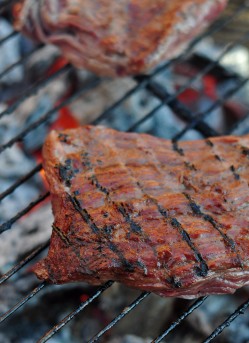Beef is perhaps the most rewarding meat to grill and eat. It is most often associated with the “all American” cookout. Because there are many cuts of beef, there are many preparation styles. The key to grilling beef is to know your meat and understand what makes it different from other cuts.
Basics for Beef on the Grill
Grilling techniques for beef vary wildly from one cut to another. Brisket is typically cooked “low and slow” for Texas style beef barbecue. Flank steak, and hanger steak are tougher cuts, but their size allows them to be seared on the outside and left rare on the inside. Slicing these cuts thinly against the grain breaks up the muscle fiber and leaves a tender bite. Steak cuts come from moderately tender muscle regions and are perfect for searing to whatever doneness you prefer. These are only three of the many cut types that could be considered.
Different Cuts, Different Techniques
When determining how to cook your beef on the grill, consider what type of muscle you are dealing with. Muscles that see much use will be tougher, since their fibers are long and well defined. Less used muscles are much more tender, and the fiber structure is almost indiscernible. Of course, ground beef bypasses the muscle fibers by grinding them up for you, making even the toughest muscles useable.
For tougher cuts, it is typically best to cook them at low temperatures for an extended amount of time. This allows the collagen in the muscle fibers to break down and become tender. The exception to this is the flank steak and its variations. Because of the flank steak’s thin profile, slicing it against the grain breaks up the muscle fibers and makes it tender.
For tender cuts, a medium to medium-low grill is best for temperature regulation and avoiding overcooking. A grill thermometer is crucial for getting a good result because it allows you to monitor the meat’s internal temperature and remove the meat from the grill at just the right time.
For steak cuts and ground beef, a medium to medium-high grill is best for achieving a good sear on the outside without overcooking the inside.
A Word About Seasoning Beef on the Grill
It may come as a surprise to some home chefs, but beef packs a lot of great flavor on its own. A robust seasoning blend, while imparting a unique and powerful flavor profile to the meat, often actually detracts from the meat flavor. Steak sauces and seasonings work wonders to cover many grilling failures, but a truly stunning steak is one that features the flavor of the beef as most prominent.
The mark of a great outdoor chef is his ability to draw out the complex savory flavors of the beef without muting them with extra flavors. You will taste sweet success when your guests realize that they don’t have to flood their steak with a sauce that steals the entire dish. To achieve the best simple steak, rub your steaks down with a liberal application of kosher salt and freshly ground coarse black pepper. Wrap the steaks individually in plastic wrap for at least 45 minutes to let the salt work it’s hydrophilic magic. After the wait, unwrap the steaks and either grill them immediately, or leave them on a wire rack in the refrigerator overnight, uncovered. The overnight method intensifies the “beefy” flavor of the steak.
Go back to BBQ Recipes Main Page
Go to iGrillBBQ.com Home Page from Beef on the Grill
 The best recipe for grilled chicken is no recipe at all. This is not to say that you shouldn’t measure your ingredients, or even use recipes as a guide, but strict adherence to a recipe will tend to impede your success as a chef. The best way to procure delicious chicken on the grill is to begin by deciding what flavor and texture you want. Remember that the best meals have a variety of complementary flavors and textures and plan accordingly.
The best recipe for grilled chicken is no recipe at all. This is not to say that you shouldn’t measure your ingredients, or even use recipes as a guide, but strict adherence to a recipe will tend to impede your success as a chef. The best way to procure delicious chicken on the grill is to begin by deciding what flavor and texture you want. Remember that the best meals have a variety of complementary flavors and textures and plan accordingly.